In this issue
Rocking the MarCom world
Businesses, governments, universities… all our organizations are coming to realize just how fundamental and widespread are the changes emanating from the web. Web technology is changing most rapidly, but users’ expectations are also changing quickly. In our customer experience testing, we find that people bring expectations from their best and most frequent experiences (Google, Amazon, e-Bay, Facebook, Yahoo!) to every website they visit. Any organization that is not constantly monitoring its visitors’ behaviour and its competitors in order to deliver better service is standing still in a fast-moving world.
Marketing and Communications have a particularly important role to play, keeping in touch with changing customer expectations and needs to set strategic communications direction. But Amazon, Google and the others recognize the weakness of applying 20th-century analysis techniques on the web, and the amazing power that new techniques – especially understanding users’ goals and task behaviour – have to offer.
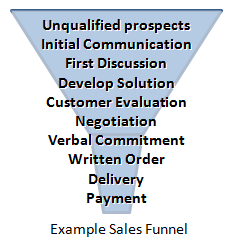 One piece of 20th-Century thinking that is well past its shelf life is the ‘Sales Funnel’, because it assumes the vendor is in control of the sales process, shepherding ‘prospects’, like sheep, through each step.
One piece of 20th-Century thinking that is well past its shelf life is the ‘Sales Funnel’, because it assumes the vendor is in control of the sales process, shepherding ‘prospects’, like sheep, through each step.
Let’s think a bit about the buying process, rather than the sales process. A person wants to buy a product. They may have a rough idea of how much they want to spend and a couple of key features or qualities they need. They first want to get a feel for the size of the decision they have to make. They may start with a search on Google, refine that search when too many results come in, then open up a few tabs to start comparison, maybe read a few reviews. Or they might use Bing maps to find some local stores where they could look at some products. Or they might put out a request on Facebook or LinkedIn for advice from ‘friends’ or other people. This is the start of the Buying Funnel.
Potential customers now have a myriad of ways in which to carry out their vendor evaluation process. You are no longer in charge, the buyer is. If you’re lucky, you’ll be in your potential customer’s buying funnel. It’s not comfortable. You’re in there with your competitors. You have no control. But you have to be there if you want to be the buyer’s provider of choice. And you can understand and measure the Buying Funnel, just as you used to measure the Sales Funnel.
Within the Buying Funnel – in fact, at all times! – product and service offers have to be made that are relevant not just to the person, but also to their specific context and task – their behaviour right at that moment. When Amazon say ‘People who like that also like this’, they’re not applying demographics or psychographics. They’re triggering on a tiny piece of behaviour and applying some heavyweight statistics, in order to make an offer to that customer that is almost certainly highly relevant to them, their context, and their current task.
Don’t take our word for it. There are already buying funnels out there. We may not always think of them as such. See the writing on the wall in the following examples:
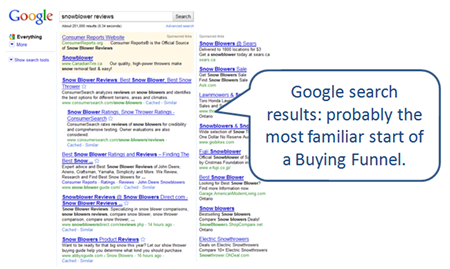
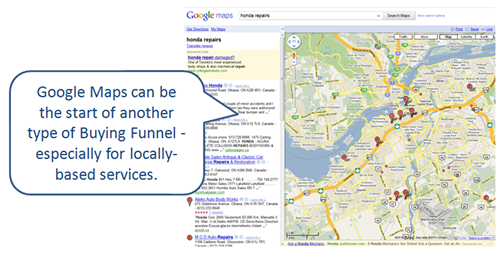

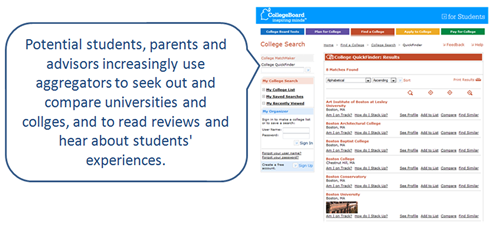
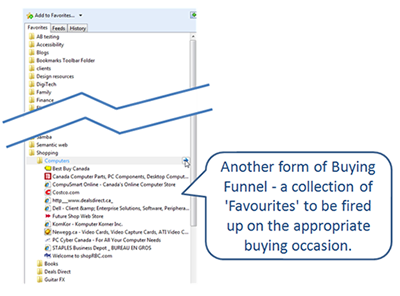
Is it Easy to Buy on your website?
At various points in the Buying Funnel process, your website will become an important factor. These are what we call the critical interactions. For example, at the top of the funnel, the buyer may visit your website just to see if you’re even in the running – if you provide the ball-park product or service they’re looking for. But while making that evaluation, they will also be refining their selection criteria, so if, for example, you provide them with a key piece of selection information, you’re much more likely to get to the next level of the Buying Funnel, as well as discounting some competitor offerings.
Another critical interaction in the middle of the funnel is when the buyer is down to the last handful of specific products, comparing features, qualities and price in detail. That has to be easy to do on your site, or you face a quick rejection, not necessarily because you didn’t have the information, but because it was not in a form that made the buying process easy for the buyer! It has to be Easy to Buy on your website – at every step of the buyer’s decision-making process.
A third critical interaction is the final purchase. Congratulations, you’ve made it to the narrow end of the Buying Funnel. But this is where we’ve seen so many commerce sites trip up. If the vendor differences are not significant to the buyer, then a poor checkout process can doom your site to oblivion. It only takes one click to get back to your competitor’s site.
We’ve seen buyers get angry because there were hidden costs. We’ve seen astonishment when they’ve found it difficult to order more than one of an item, but in different sizes. We’ve seen users abandon a site because they couldn’t find out the tax and shipping costs without going through the checkout process.
To make it easy to buy, your product has to be easy to find. Your navigation has to reflect the buyers’ view of the world, not the way your organization sees it (for example, don’t force buyers to decide if they are ‘Consumers’, ‘Small Businesses’ or ‘Enterprises’ etc.). Links have to use buyers’ words, not yours. Layout has to make it easy to scan for just the information the buyer needs – no more and no less. Search has to work well for your customers’ buying-oriented search phrases.
Sites that provide the information the buyer needs in the minimum number of steps are much more likely to remain in the Buying Funnel. Sites are likely to be quickly rejected if they impose just one unnecessary click, or have one low-confidence link label, or provide a poor first set of search results, or that request one piece of personal information too much, or lack one critical piece of information.
The deep and long-term change the web is going through now is to give more power to users. This process is going to take many years – even decades – to complete. In the short term, you have to learn to see the world from the buyer’s perspective, at the behavioural level of detail, and match their Buying Funnel process step-by-step.
First, understand. Put last-Century blinkers aside, go back to raw data and find out what your users, visitors, audiences and buyers are really doing.
Find out more about these changes and what you can do about them: 
- Download the FREE white paper ‘Using Your Customers’ Desired Actions to Increase Your Sales’ (PDF 1MB). In this new white paper, Kristin Zhivago and Gerry McGovern give many examples and ideas on how organizations can remove barriers to buying and shift from seller-centric to buyer-centric.
There are other people who get what’s happening… here’s a couple to listen to:
- Mark Sellers – Why the Sales Funnel is Outdated (4m20sec video interview)
- Mitch Joel – The Last Mile of Marketing (blog entry)
Ask us to help make it Easy to Buy on your website by removing barriers in the buying process. Ask us to review your Buying Funnel, to measure your users’ task performance and identify where you could best make improvements to match their needs and behaviour. Even if the products you’re selling are information, ideas or an education, and even if you’re giving them away for free! Talk to us – 1-866 322 8522 or email us.
- Many of you will know Gerry McGovern’s excellent book promoting user-centred web design: Killer Web Content. Well, he has another book due to be published in July. Take an advance peek at: The Stranger’s Long Neck: How to Deliver What Your Customers Really Want Online.
- RT @gerrymcgovern Time is (still) money: Time for intranet leadership (Part 2): http://tinyurl.com/34uc8rk [See also: Increasing employee productivity (Part 1): http://tinyurl.com/33ha6gp]
- Web Strategy from User Behaviour – Mike’s J Boye Conference presentation on slideshare: http://bit.ly/Web_Strategy_from_Behaviour
- Canadian Internet Use Survey results published: http://bit.ly/Can_Internet_Survey
- Astonishing dystopian vision of User Experience/Augmented Reality, 1m46sec video by Keiichi Matsuda http://bit.ly/DystopianReality
Quote of the month
“There will always, one can assume, be need for some selling. But the aim of marketing is to make selling superfluous. The aim of marketing is to know and understand the customer so well that the product or service fits him and sells itself.”
Peter Drucker



